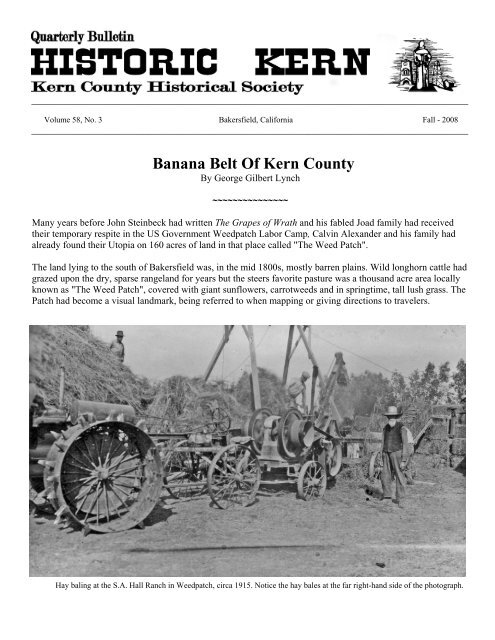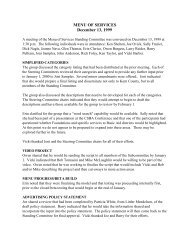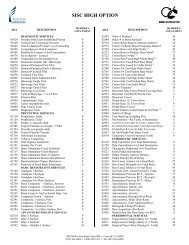Vol53, No3, Fall 2008.pub - Kern County Superintendent of Schools
Vol53, No3, Fall 2008.pub - Kern County Superintendent of Schools
Vol53, No3, Fall 2008.pub - Kern County Superintendent of Schools
Create successful ePaper yourself
Turn your PDF publications into a flip-book with our unique Google optimized e-Paper software.
__________________________________________________________________________________________<br />
Volume 58, No. 3 Bakersfield, California <strong>Fall</strong> - 2008<br />
__________________________________________________________________________________________<br />
Banana Belt Of <strong>Kern</strong> <strong>County</strong><br />
By George Gilbert Lynch<br />
~~~~~~~~~~~~~~~<br />
Many years before John Steinbeck had written The Grapes <strong>of</strong> Wrath and his fabled Joad family had received<br />
their temporary respite in the US Government Weedpatch Labor Camp, Calvin Alexander and his family had<br />
already found their Utopia on 160 acres <strong>of</strong> land in that place called "The Weed Patch".<br />
The land lying to the south <strong>of</strong> Bakersfield was, in the mid 1800s, mostly barren plains. Wild longhorn cattle had<br />
grazed upon the dry, sparse rangeland for years but the steers favorite pasture was a thousand acre area locally<br />
known as "The Weed Patch", covered with giant sunflowers, carrotweeds and in springtime, tall lush grass. The<br />
Patch had become a visual landmark, being referred to when mapping or giving directions to travelers.<br />
Hay baling at the S.A. Hall Ranch in Weedpatch, circa 1915. Notice the hay bales at the far right-hand side <strong>of</strong> the photograph.
For hundreds <strong>of</strong> years, Caliente Creek, during heavy rains in the Tehachapi Mountains, had deposited, in its<br />
alluvial fan, rich topsoil and seed spread over thousands <strong>of</strong> acres. This work <strong>of</strong> nature would in time become the<br />
famous "Weed Patch". Richness <strong>of</strong> the soil in portions <strong>of</strong> this delta were legendary, reportedly sunflowers with<br />
stalk diameters <strong>of</strong> five inches were common and tall enough to shade grazing cattle.<br />
In the mid 1870s this land was "dry farmed" with hundreds <strong>of</strong> acres <strong>of</strong> wheat and barley which grew fine -- if<br />
the rains came. A few pioneer farmers had succeeded in raising potatoes, grapes and some fruit trees in this area<br />
by hauling irrigation water in wagons to nurture their crops to maturity. Irrigation by water wagon was a 24/7<br />
job and only the most robust, dedicated farmers could succeed in realizing a pr<strong>of</strong>itable crop. A canal was the<br />
only solution to bring water to this fertile area and in 1892 plans were underway to remedy the situation.<br />
Captain John Barker owner <strong>of</strong> Rio Bravo Ranch, at the mouth <strong>of</strong> <strong>Kern</strong> River Canyon, had been granted state<br />
permission to begin a canal project to run from his ranch to the Weedpatch area. It was illustrated on some early<br />
maps as a "Proposed Canal", named, "The 78 Canal Project". The newspaper stories <strong>of</strong> the day stated; The<br />
wealthy backers <strong>of</strong> Barkers project, which included mining and horse racing czar "Lucky Baldwin" along with<br />
several prominent businessmen, backed out <strong>of</strong> the deal at the last minute. Captain Barker had completed the<br />
headworks and the primary construction <strong>of</strong> the canal on his property. The remains <strong>of</strong> this canal can still be<br />
viewed today at the south end <strong>of</strong> the Lake Ming overflow parking lot near <strong>Kern</strong> River Golf Course.<br />
The next year, 1893, James Haggin, <strong>of</strong> <strong>Kern</strong> <strong>County</strong> Land Company (KCLC) and A.N. Towne, general manager<br />
<strong>of</strong> the Southern Pacific Railroad, financed construction <strong>of</strong> the "Eastside Canal Extension", which extended the<br />
existing canal from the Southern Pacific Railroad yards in East Bakersfield to the Towne Ranch near<br />
Weedpatch. This project finally provided irrigation water to this fertile "Banana Belt" <strong>of</strong> the Southern San<br />
Near the banks <strong>of</strong> <strong>Kern</strong> Lake with a view <strong>of</strong> Bear Mountain in the distance, circa 1905.
Joaquin Valley. This southern farming area, Weedpatch, Arvin,<br />
Lamont and <strong>Kern</strong> Lake, were favored because the crops matured<br />
two to four weeks earlier than most other valley regions and<br />
bringing produce to the Los Angeles market early paid bonus<br />
prices. Farmers immediately recognized the great potential <strong>of</strong> this<br />
area and began to purchase the land while prices were still<br />
reasonable.<br />
Calvin B. Alexander and his family came to California from<br />
Indiana in 1893 and purchased their 160 acres in 1898. It was<br />
located 16 miles south west <strong>of</strong> Bakersfield where Fairfax Road<br />
(State Highway 184) and Buena Vista Road now intersect. Calvin<br />
and his oldest son John were highly respected in the community as<br />
devoted and industrious farmers and experts in draft horse<br />
breeding. Percheron-Norman blooded stallions were their specialty.<br />
These are large hooved work horses <strong>of</strong> great size and strength. The<br />
ownership <strong>of</strong> a matched team <strong>of</strong> these beautiful animals, in those<br />
days before tractors, was a valued asset to farmers for moving<br />
heavy wagons and large gang plows.<br />
Henry Jastro<br />
The Alexanders were successful in raising a variety <strong>of</strong> crops, but alfalfa, (then the equivalent <strong>of</strong> today's<br />
Gasoline), was always in demand and Calvin was one <strong>of</strong> the first to commercially raise it in this district. The<br />
Alexanders were one <strong>of</strong> the first successful cotton growers in <strong>Kern</strong> <strong>County</strong> and a cotton gin was built in the<br />
growing Weedpatch settlement to shorten the hauling distance from the nearby fields.<br />
The little town <strong>of</strong> Weedpatch was founded in 1922. Over the years a village had grown up around Calvin's<br />
home and was commonly known as "Alexander's Corner", in time it featured a post <strong>of</strong>fice, general store,<br />
restaurant, church , garage, cotton gin and a blacksmith shop. It had become the trading center <strong>of</strong> that area. The<br />
land for the church was donated by the Alexander family. Today, a humble little lane dedicated to this family is<br />
named "Alexander Street", in the small town <strong>of</strong> Weedpatch, California. The street post displays the names;<br />
Alexander and Parish streets. Judge Frank Parish, in 1920, owned the Weedpatch Market and presided over the<br />
15th Township Justice Court which was located in a back room <strong>of</strong> the store at "Alexander’s Corner", Judge<br />
Parish's son Oral succeeded him as judge in 1939.<br />
Electricity came to the Weedpatch-<strong>Kern</strong> Lake area in 1911. The expensive transmission wires and transformers<br />
were installed primarily to operate irrigation pumps for KCLC farming operations in that area but it also<br />
afforded power to all the outlying farm communities south <strong>of</strong> Bakersfield. The dim, smelly kerosene lamps used<br />
for home lighting were on their way out and crops were never lost due to droughts now that electric pumps<br />
could provide ample water from deep wells.<br />
Five miles west <strong>of</strong> Weedpatch was an area known as <strong>Kern</strong> Lake. It was quite a large body <strong>of</strong> water and when<br />
full it measured about 5 by 4 miles in area. This lake originally received the waters <strong>of</strong> the Old South Fork <strong>of</strong> the<br />
<strong>Kern</strong> River combined with a score <strong>of</strong> meandering sloughs. Levees were built to prevent the lake from filling but<br />
occasionally, when the river flooded, a levy would wash out and <strong>Kern</strong> Lake would refill. When this occurred,<br />
the families, which lived nearby, had a great swimming, boating and fishing hole for recreation, until the hot<br />
sun dried it back into dry land again. <strong>Kern</strong> <strong>County</strong> Land Company, the owner, leveled the lake bottom area to<br />
conform to incline irrigation from the "<strong>Kern</strong> Island Canal" which entered the area from the north. Later, when<br />
electricity became available from the new <strong>Kern</strong> Canyon Power Plant, wells were dug and irrigation pumps<br />
installed for use when river water ceased to flow in the dry summer months. This fertile lake bed district proved<br />
excellent for growing cotton. The First World War created a great demand for long staple cotton, used for the
strong fabric covering <strong>of</strong> aircraft. This plus increasing domestic use <strong>of</strong> cotton caused many more thousands <strong>of</strong><br />
acres <strong>of</strong> cotton to be raised in <strong>Kern</strong> <strong>County</strong>.<br />
<strong>Kern</strong> <strong>County</strong> Land Company, in 1890, had attempted to create colonies as a means <strong>of</strong> selling their land in 40<br />
and 60 acre parcels. Their "showcase" colony, Rosedale, failed because the East Coast and European farmers<br />
who bought the land had never attempted to manage a large, irrigated farm and in time most immigrants who<br />
bought the acreage were bankrupt and couldn't make the payments, consequently the land reverted back to the<br />
<strong>Kern</strong> <strong>County</strong> Land Company by default. Henry Jastro became the new manager <strong>of</strong> the Land Company and<br />
greatly restricted land sales, heading the company into large scale cattle operations exclusively.<br />
By 1910, under Jastro's leadership, the <strong>Kern</strong> <strong>County</strong> Land Company was the largest cattle company in<br />
America, twice the size <strong>of</strong> the King Ranch in Texas. It owned more than 2,000,000 acres in four states and the<br />
owners were content to remain exclusively in cattle raising but gradually began to place <strong>Kern</strong> acreage into<br />
leasing to farmers but only those who had proven themselves pr<strong>of</strong>icient at large scale farming in this area. The<br />
Land Company had learned its lesson about inept farmers during the colonizing experiment <strong>of</strong> 1890.<br />
<strong>Kern</strong> Lake and Paloma were the scenes <strong>of</strong> the first attempt by KCLC to get into the tenant farming business.<br />
Initial influx came in 1925 when 5,400 acres were leased by the Alexander, Rudrum, Banducci, Fanucci, Pieri,<br />
Simoni, Hill and Frick families. This was increased to 8,000 acres by 1936, with cotton and barley evenly<br />
divided among the acreage. These farmers had a few good years until the cotton crop <strong>of</strong> 1931 and 32 was<br />
marketed at such a low price, everyone suffered a total loss. The Great Depression was hitting hard on everyone<br />
at that time and many farmers were forced to<br />
mortgage their homes just to get by.<br />
The next year, 1933, saw a good market price and<br />
most farmers recovered their losses but the farmers<br />
good fortune sparked a Valley-wide cotton strike,<br />
(only 20 percent <strong>of</strong> the cotton pickers favored<br />
striking for higher wages), the strikers wanted<br />
$1.00 to pick a hundred pounds <strong>of</strong> cotton, the<br />
farmers were paying $.60 per hundred which was a<br />
20% raise in wages over the previous year. Armed<br />
conflict and rioting took place in the Weedpatch-<br />
<strong>Kern</strong> Lake area on Oct. 10, 1933 when 150<br />
picketing agitators arrived in a caravan <strong>of</strong> trucks.<br />
Within a few hours violence erupted between the<br />
strikers and Sheriff and Highway Patrol <strong>of</strong>ficers on<br />
the E.O. Mitchell Ranch east <strong>of</strong> <strong>Kern</strong> Lake. As the<br />
police and ranchers tried to protect field workers<br />
from harm, 13 people were seriously injured and<br />
one striker was killed during the two hour battle.<br />
The man killed was Pedro Subia <strong>of</strong> Arvin, a striker,<br />
suffering a bullet wound to his chest. Witnesses<br />
stated the shot came from the strikers ranks.<br />
Merced Velos, a striker, had his arm blown <strong>of</strong>f<br />
from a shotgun blast. Receiving severe head<br />
injuries from repeated blows by strikers, wielding<br />
clubs, were prominent local residents, Hugh S.<br />
Jewett chairman <strong>of</strong> the <strong>Kern</strong> <strong>County</strong> Water<br />
Development Commission and Lloyd Frick<br />
J.T. Phillips in a Weedpatch cotton field, September 1, 1925.
president <strong>of</strong> the California Cotton Growers Association, both taken, unconscious, to <strong>Kern</strong> General Hospital,<br />
shortly thereafter both recovered from injuries. Miraculously, it rained the two following days which cooled<br />
tempers and within a week workers returned to the cotton fields. On October 25, California Governor James<br />
Rolph, Jr. negotiated a compromise wage <strong>of</strong> $.75 per hundredweight for the pickers, peace and quiet once again<br />
returned to the <strong>Kern</strong> cotton fields.<br />
Oil was discovered on KCLC holdings about 1936 and they decided to list 15% <strong>of</strong> the company’s stock on the<br />
New York Stock Exchange. The stock brought $33 per share and within 5 years had rocketed to a worth <strong>of</strong><br />
$1,240.00 per share. The company began vast land reclamation projects and crop sharing lease agreements as a<br />
use for the excess income from oil dollars in order to lighten the corporation’s federal tax burden. This was a<br />
boon to the <strong>County</strong> <strong>of</strong> <strong>Kern</strong>, the lessee farmers and KCLC. By the late 1930s the Land Company was a tribusiness<br />
corporation, agriculture, oil and cattle. Oil was the real cash cow, with over 800 wells on KCLC<br />
property.<br />
The thousands <strong>of</strong> dollars in costs to transform native soil into a fertile productive farm is enormous. Leveling,<br />
grading and ditching for irrigation, sinking wells and providing pumps, living quarters, out buildings and<br />
equipment to maintain. Development such as this is beyond the average farmer’s means but could be done<br />
easily by the KCLC. They owned thousands <strong>of</strong> acres in the <strong>Kern</strong> Lake district and their management had<br />
devised a plan <strong>of</strong> leasing, that over the years proved to be highly beneficial to hundreds <strong>of</strong> farmers. A man, with<br />
limited capitol, could contract with KCLC to lease 100, 400 and even more acres if he was a proven pr<strong>of</strong>icient<br />
farmer.<br />
Their land leasing system was operated by crop sharing partnerships. The Land Company cleared and leveled<br />
the ground with their heavy equipment, dug deep wells and installed irrigation pumps, put in stand pipes and<br />
ditches and if required, three alfalfa crops would be pre-grown to improve the soil fertility before the lessee<br />
took possession. If the farmer who leased the land successfully brought the crop to harvest, he paid a share <strong>of</strong> it<br />
to KCLC, usually 1/4 to 1/3. If his crop failed, he owed no rent for that growing season. This left the farmer free<br />
to use all his capitol and credit on equipment, seed, fertilizer and labor costs. Tracts were leased in units large<br />
enough to encourage the use <strong>of</strong> machinery and give the tenant a chance to make pr<strong>of</strong>its on large scale<br />
operations. This partnership plan, over the years, allowed scores <strong>of</strong> ranchers to operate at a good pr<strong>of</strong>it and to<br />
eventually purchase ranches <strong>of</strong> their own. Scores <strong>of</strong> famous <strong>Kern</strong> <strong>County</strong> farming operations began by using<br />
this system <strong>of</strong> land leasing.<br />
The pioneer families who lived on these farm leases at <strong>Kern</strong> Lake were 15 or more miles from town and getting<br />
to and from high school in Bakersfield was a tough situation for farm kids because they had their farm chores to<br />
perform as well as school to attend. Before automobiles, for many, it was a long daily trip by saddle or buggy.<br />
In 1917, that all changed when our progressive <strong>County</strong> provided school buses from their fleet <strong>of</strong> 87, which was<br />
the largest in the state at that time.<br />
To protect their crops from the hoards <strong>of</strong> wild rabbits, the whole community would frequently gather at the<br />
local school or church for a big rabbit drive. The enormous rabbit population, if not controlled, could eat the<br />
farmers into ruin in a short time. These events became major weekend social affairs featuring, barbeques,<br />
dances and games, everyone joined in herding hundreds <strong>of</strong> the crop munchers into fenced areas where they were<br />
captured and thereafter became stew, chili or Southern fried.<br />
Today, much <strong>of</strong> the Weedpatch-<strong>Kern</strong> Lake district is still used to grow marvelous Acala cotton crops and barley<br />
fields wave in the breeze resembling the waves <strong>of</strong> old <strong>Kern</strong> Lake <strong>of</strong> the past, but as one tours the lush, green,<br />
fields it is apparent "Baby Carrots" now dominate the scene. <strong>Kern</strong> <strong>County</strong> has emerged from being the Cotton<br />
King to the Carrot King <strong>of</strong> America. The millions <strong>of</strong> rabbits that plagued farmers in the early years would<br />
decimate a field <strong>of</strong> carrots in a matter <strong>of</strong> days but now the rodents are rarely seen. I wonder if the pioneers could
have ever imagined the lowly carrot becoming a major cash crop <strong>of</strong> "The Banana Belt Of The San Joaquin<br />
Valley".<br />
© George Gilbert Lynch<br />
Marjorie (Marje) Ellen Rump 1919-2008<br />
Marjorie Ellen Rump (89) passed away after a long illness on December 23, 2008, at<br />
Glenwood Gardens, where she has resided the last two years in Bakersfield. She was born<br />
Marjorie Gummig in St. Joseph, Missouri on January 19, 1919. Her parents, Dr. Edward<br />
August Gummig and Adeline Boller Gummig, moved with daughter Marjorie and son<br />
Dwight to Pasadena, California in the late 1920s. As a young teen, Marjorie worked in her<br />
father's medical <strong>of</strong>fice during high school summers and was taught to drive by an ambulance<br />
driver. She graduated from Pasadena Junior College in a class <strong>of</strong> over 1,000 students. Marjorie attended the<br />
University <strong>of</strong> Redlands, graduating in 1941 and was honored with an alumna Jubilee Heritage Award in 1983.<br />
She was a member <strong>of</strong> Beta Lambda sorority and has maintained contact with members over the years through<br />
round-robin newsletter. She earned a teaching credential and taught speech and drama at Beaumont High<br />
School.<br />
During the Second World War, she started corresponding with a young Colorado School <strong>of</strong> Mines engineering<br />
grad named "Jack", for whom his Auntie Myra played the matchmaker. They were married on July 25, 1943 at<br />
the Church <strong>of</strong> the Redeemer in Biloxi, Mississippi, where Jack was working for the U.S. Bureau <strong>of</strong> Ships. At<br />
war's end, her husband was transferred to San Pedro, California, where their son Jack Edward was born.
Thereafter, Marje and Jack lived in Fellows and Taft when Jack went to work for Texaco Oil as a petroleum<br />
engineer. Marjorie started Taft Community Theater and gave birth to daughters Susan and Marilyn<br />
in the early fifties.<br />
The family moved to Bakersfield in 1953. Marjorie worked as substitute teacher and as book buyer for Sierra<br />
Book Store when her children were small. In the 1970s, she went back to school for a Master's degree in<br />
Library Science, attending USC over four consecutive summers. She worked briefly at East High School as a<br />
librarian, then was hired by the <strong>Kern</strong> <strong>County</strong> Library System and over the next 35 years worked several jobs<br />
from branch manager to bookmobile supervisor to Deputy Director. Marjorie was in charge <strong>of</strong> the Beale Library<br />
move to its current location on Truxtun Avenue. She retired in 2000 at the age <strong>of</strong> 81.<br />
Marjorie was deeply connected in the local community with memberships in Soroptimists, PEO, AAUW,<br />
Friends <strong>of</strong> the Library, First Presbyterian Church, and Assistance League, where she volunteered regularly at<br />
the Bargain Box. She also served with her husband Jack on the board <strong>of</strong> Conference <strong>of</strong> California Historical<br />
Societies (CCHS) and helped edit many local publications on early California history.<br />
Marje was a driving force in the <strong>Kern</strong> <strong>County</strong> Historical Society having served as president from 1981-1982.<br />
She also served on the publications committee, and until recently took care <strong>of</strong> all the Society’s book sales. She<br />
helped to teach many <strong>of</strong> us about the importance <strong>of</strong> our heritage through her strong actions. Marje will be<br />
deeply missed and her void in the Society cannot be expressed with words.<br />
Two Giant Grapevines<br />
By Gilbert Gia<br />
In 1937 a seventy year-old grapevine grew in the back yard <strong>of</strong> Mrs. C.D. Neely's residence at 2315 Q Street in<br />
Bakersfield. Mrs. Neely knew the age <strong>of</strong> the plant because many years earlier her grandfather M. Odell [Milan<br />
Odell], who was a partner with Thomas Baker in a meat supply business, told her that Baker planted the vine<br />
himself about 1867. The base was 62 inches around. In days when life was a bit simpler, Mrs. Neely said the<br />
grapevine was the biggest one in the world. Today a communications company is at 2315 Q Street, and there<br />
doesn’t seem to be a grapevine anywhere.<br />
The Internet probably notes a bigger grapevine, but as late as 1954 a really huge one grew in <strong>Kern</strong> <strong>County</strong> along<br />
the lower Mil Potrero Highway between Maricopa and Pine Mountain Club. I heard about it from Philip<br />
Munding who was raised as a lad around that part <strong>of</strong> the county, but I never saw the vine myself. Years back the<br />
<strong>Kern</strong> <strong>County</strong> Historical Society found it and reported that the spring-fed plant covered an entire acre <strong>of</strong> ground<br />
(Historic <strong>Kern</strong>, March 1954). Locating the vine today is a challenge because property along Mil Potrero<br />
Highway is mostly fenced and private, and nothing about the vine has been written in years. Can any readers<br />
tell us about it<br />
Giant Thank You<br />
In keeping with the giant theme, I would like to send a giant thank you to Don Arnot. For several years, Don<br />
who served as the society’s president from 2000-2001, has faithfully and pr<strong>of</strong>essionally laid out this<br />
publication. It made my job and the job <strong>of</strong> former editors much easier as I am now finding out. I would like to<br />
thank Don for his service, expertise, and his willingness to share his knowledge with me. Jeff<br />
Historic photos: <strong>Kern</strong> <strong>County</strong> Museum<br />
Marje Rump photo: Susan Steinbach<br />
If you have any ideas for articles to be published in Historic <strong>Kern</strong>, please contact Jeff Nickell, Editor by<br />
mail at 3801 Chester Avenue, or by e-mail at jenickell@kern.org.
—Quarterly Bulletin —<br />
The <strong>Kern</strong> <strong>County</strong> Historical Society<br />
Post Office Box 141<br />
Bakersfield, California 93302<br />
Non-Pr<strong>of</strong>it Organization<br />
U.S. POSTAGE<br />
PAID<br />
Bakersfield, CA 93302<br />
PERMIT NO. 870<br />
Return Service Requested<br />
___________________________________________________________<br />
Book<br />
<strong>Kern</strong> <strong>County</strong> Wayfarers (Paperback)<br />
William Harland Boyd<br />
Book<br />
Price<br />
Tax<br />
Total<br />
9.95 .72 10.67<br />
Basques To Bakersfield Mary Paquette 15.00 1.09 16.09<br />
Stagecoach Heyday In The San Joaquin<br />
Valley (1853-1878) William Harland Boyd<br />
5.00 .36 5.36<br />
<strong>Kern</strong> <strong>County</strong> Pioneer Recollections 18.95 1.37 20.32<br />
<strong>Kern</strong> <strong>County</strong> Place Names Second Edition<br />
Curtis Darling<br />
Historical Site Markers In <strong>Kern</strong> <strong>County</strong><br />
(Paperback) William Hample<br />
Lower <strong>Kern</strong> River Country 1850-1950<br />
William Harland Boyd<br />
<strong>Kern</strong> <strong>County</strong>’s Desert Country—An Historical<br />
Overview William Harland Boyd<br />
Life On The Elk Hills Oil Field (S<strong>of</strong>tcover Booklet)<br />
Chinese In <strong>Kern</strong> <strong>County</strong>, 1857-1960 — Based on<br />
pioneer oral histories<br />
Curtis Darling Post Card Collection, Volume 1<br />
(Paperback) Don Arnot & Jeff Nickell<br />
18.95 1.37 20.32<br />
11.95 .87 12.82<br />
18.95 1.37 20.32<br />
16.95 1.23 18.18<br />
7.95 .58 8.53<br />
24.95 1.81 26.76<br />
13.95 1.01 14.96<br />
Please make checks payable to <strong>Kern</strong> <strong>County</strong> Historical Society, add $4.00 per order<br />
for postage & handling, and mail to the address below.<br />
<strong>Kern</strong> <strong>County</strong> Historical Society<br />
Officers And Chairpersons<br />
President<br />
Vice-President<br />
Treasurer<br />
Secretary, Corresponding<br />
Secretary, Recording<br />
Board Of Trustees<br />
One Year<br />
Bill Burke<br />
Ernie Hull<br />
Jeff Krausse<br />
Jeff Nickell<br />
Rebecca Orfila<br />
Auditor<br />
Book Sales<br />
C.C.H.S. Liaison<br />
Education<br />
Historian<br />
Historic <strong>Kern</strong><br />
Historical Research<br />
K.C.M. Liaison<br />
Landmarks<br />
Membership<br />
Nominating<br />
Oral History<br />
Programs/Tours<br />
Publications<br />
Publicity<br />
Reservations<br />
Website<br />
Committee Chairs<br />
Gilbert Gia<br />
Lori Wear<br />
Gary Wilcox<br />
Enid Hull<br />
Sarah Woodman<br />
Two Year<br />
William St. Clair<br />
Krista Moreland<br />
Ken Hooper<br />
Jerry Bowen<br />
Bill Burke<br />
Krista Moreland<br />
Bill Burke<br />
Ken Hooper<br />
Jenelle Wilcox<br />
Jeff Nickell<br />
Gilbert Gia<br />
Jackie Brouillette<br />
Gary Wilcox<br />
Lori Wear<br />
Jerry Bowen<br />
Lori Wear<br />
Jeff Nickell<br />
Lori Wear<br />
Lori Wear<br />
<strong>Kern</strong> <strong>County</strong> Historical Society<br />
P.O. Box 141<br />
Bakersfield, CA 93302<br />
Please visit our website at<br />
www.kchistoricalsociety.org








